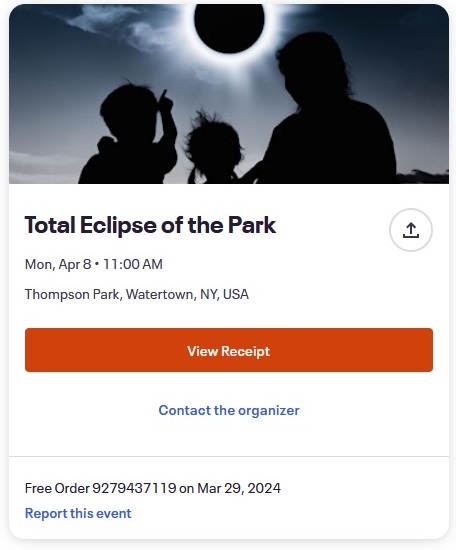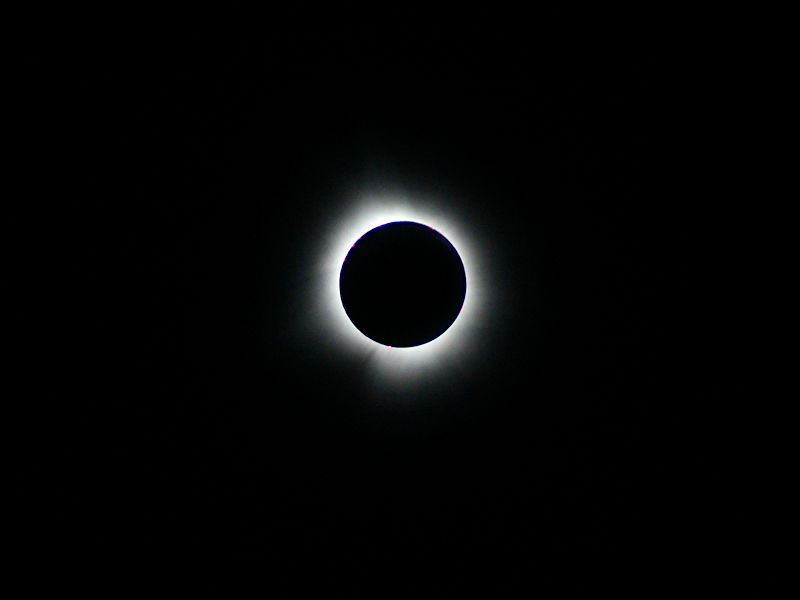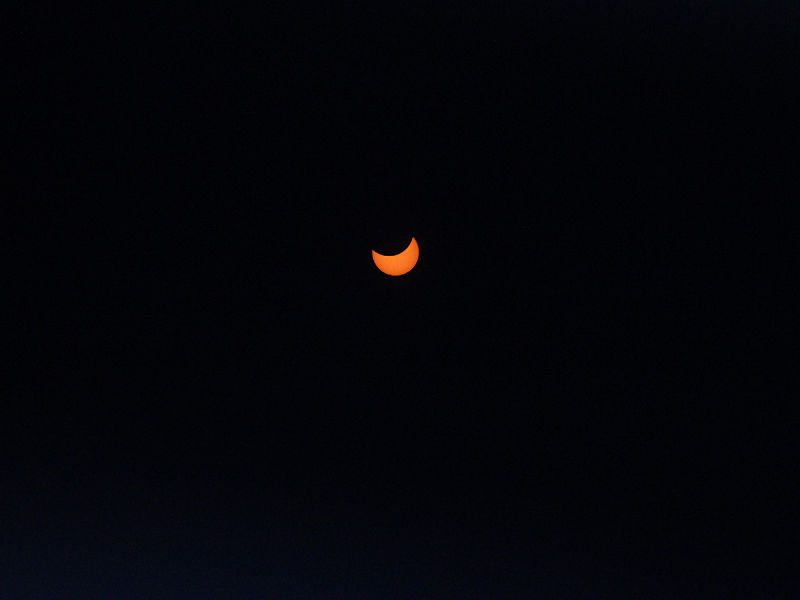PRINT AS PDF
Following the August 21, 2017 partial solar eclipse in the New York City area, I set a goal of seeing the total solar eclipse of April 8, 2024. At that time, I planned to travel to the Buffalo or Niagara Falls areas. The partial annual eclipse just after sunrise on June 10, 2021 reinforced my determination to see the 2024 total eclipse.
Based on emerging cloud cover forecasts in late March, I obtained tickets for the “Total Eclipse of the Park” event to be held in Watertown, NY’s historic Thompson Park. A great lineup of events was scheduled for Eclipse Day.
However, just days later, I shifted my planned location to Plattsburgh, NY, as the cloud cover looked increasingly unfavorable for the Watertown area.
On Saturday, April 6, the guidance consistently revealed less favorable sky conditions for Plattsburgh and also nearby Burlington. I reviewed the guidance for options in Quebec, New Hampshire, and Maine and settled on Maine. After a review of locations in the path of totality in Maine, I selected Moose River, ME (population: 227) in Somerset County (population: 50,715).
The following day saw the forecasts hold up. The Sunday, April 7 15z cloud forecast showed 3% cloud cover for the Moose River area (Greenville location) at 1 pm and 0% at 3 pm and 4 pm. The location was finalized and I left New York at just before 2 pm for Maine.
I viewed the eclipse from St. Anthony’s Cemetery, which lies on Old Route 201 just across the border from Moose River in Jackman. The cemetery has few trees and a good view of the sky.
I arrived there early on Monday morning. By Noon numerous vehicles had parked alongside the Cemetery. A number of people put out lawn chairs between the parked vehicles.
Several areas of high clouds pushed across the sky from the northwest starting during the late morning. The arrival of high clouds was not surprising, as the NBM cloud cover guidance indicated this development. That guidance also suggested that all of the clouds would pass and dissipate prior to the start of the eclipse. Would the guidance prove correct?
By 1 pm, the high clouds were disappearing from the sky. The temperature had risen into the middle 50s after having begun the day at a chilly 25°. The sun’s warmth continued to melt the snow from a snowstorm that had blanketed the area with 13.0” of snow during the preceding week. Areas of naked ground appeared and expanded rapidly as the snow melted under the brilliant sunshine.
By 2 pm, as the onset of the solar eclipse neared, all of the high clouds had vanished. The sky was perfectly clear in all directions. A gusty breeze had increased in strength. One family started an “eclipse barbecue.”
At 2:18:55 pm, the Moon began cross the plane of the Sun and the eclipse event got underway. One could safely view the event with American Astronomical Society (AAS)-certified ISO 12312-2 standard solar glasses. As the event proceeded, the temperature began to fall and the wind picked up. Within a few minutes of totality, the sunlight grew noticeably dimmer.
Totality commenced at 3:29:50 pm. It was as if one turned off a light at night, instantly plunging a room into darkness. As totality set in, the badly faded sunset abruptly gave way to darkness. The crowd immediately fell silent. Even the breeze seemed to die off. The temperature grew noticeably cooler from the loss of solar insolation and rapid onset of strong radiational cooling. The air was stripped of its remaining warmth.
Even as the crowd was connected in the experience, along with its shared hopes and expectations, the reality that the Earth is little more than a speck in the seemingly endless ocean of the Universe became apparent. Despite what human society has become and what it has achieved, one was powerfully reminded that it is still very small in the cosmic realm of things.
During the mid-afternoon darkness, celebratory fireworks were launched in the distance. Although they were out of sight from the location at which I viewed the eclipse, their sound reverberated across the landscape.
As the total eclipse continued, it seemed that the passage of time itself had been suspended. One could see a giant prominence near the bottom of the Moon’s shadow where its silhouette gave way to the white glow of the Sun’s corona even with one’s naked eye. Aside from the exploding fireworks, the all-encompassing silence continued.
For 3 minutes and 26.7 seconds, the Moon eclipsed the Sun. Once the sun burst out from behind the retreating Moon’s shadow, many of the gathered people erupted in applause. The lead actors in the grand spectacle that had taken place—the Sun and the Moon—could never know how their performance had been received.
If the unique shared experience provided a singular lesson, it was that all of us are on the same boat with one another sailing through the dark ocean of an ever-expanding Cosmos. By ourselves, we are insignificant. We cannot influence much on the cosmic scale. However, we all contribute to our boat’s wellbeing and the journey it takes. Therefore, if we are good to one another, our tiny inconsequential world—a world that is meaningful only to us and all that inhabit it—will be a better place.
Following the end of totality, the Moon gradually but steadily relaxed its hold on the sun. The event ended at 4:39.28 pm. Life returned to normal. A massive traffic jam awaited.
The next total solar eclipse will occur on August 12, 2026. The path of totality will cover parts of Greenland, Iceland, and Spain.
Select Facts:
- A total solar eclipse occurs approximately every 18 months
- A total solar eclipse occurs an average of once every 375 years at any one location
- One can only safely view the solar eclipse with the naked eye during totality
- Even at 99% coverage, the sky will be 10,000 times brighter than at totality
- 3,000 North American communities and 32 million people in Canada, Mexico, and the United States resided in the path of totality
Source: White Paper 2022 (K. Russo)
Six photos:
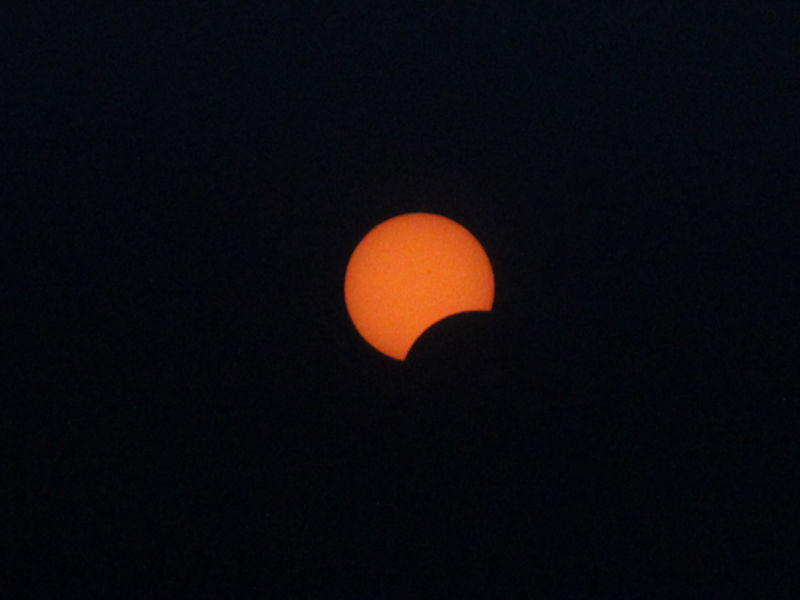
Partial eclipse before totality

Partial eclipse just before totality
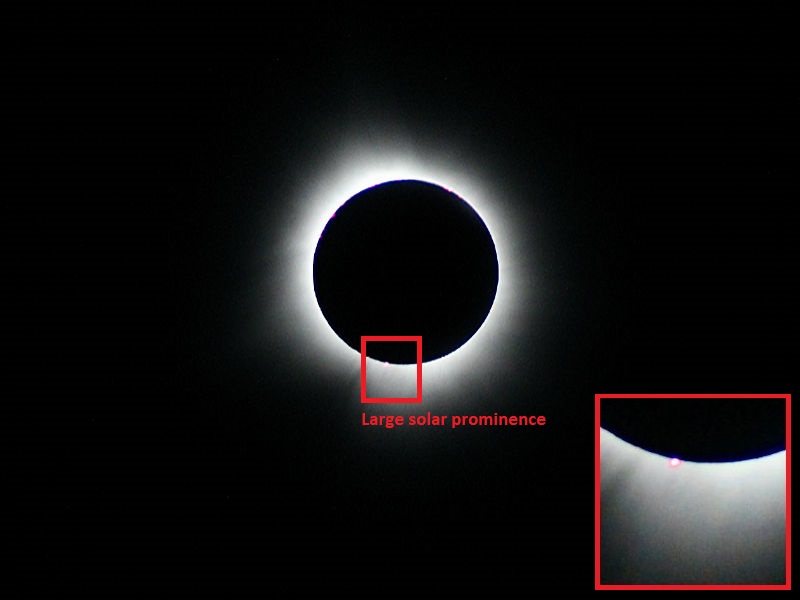
Total eclipse (large solar prominence highlighted)

Total eclipse with a display of the Purkinje Effect where peak luminescence shifts toward the blue end of the spectrum due to limited lighting

